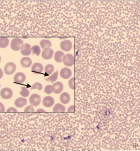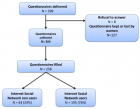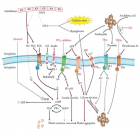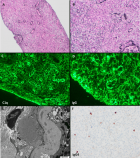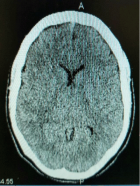About Federal Medical Centre
Federal Medical Centre
Articles by Federal Medical Centre
Prevalence of congenital heart diseases among primary school children in the Niger Delta Region of Nigeria, West Africa
Published on: 26th September, 2019
OCLC Number/Unique Identifier: 8333013062
Introduction: Congenital heart diseases (CHD) are leading causes of childhood morbidity and mortality especially in developing countries. Community-based studies are important in ascertaining the burden of the disease.
Objectives: The study was set out to determine the prevalence and types of CHD among primary school children in Port Harcourt Local Government Area (PHALGA) of Rivers State, Niger Delta, Nigeria.
Methods: A total of 1,712 primary school pupils were selected by multistage sampling from twelve schools in PHALGA. A questionnaire was used to obtain information from pupil’s parents on their child’s biodata and symptoms suggestive of heart disease. General physical and cardiovascular system examinations were carried out on each selected pupil, following which those with symptoms and/or signs suggestive of heart disease had echocardiographic confirmation of their cardiac status.
Results: The 1,712 subjects were aged 5-14 (mean 8.48 ± 2.30) years. 874 (51.1%) were females while males were 838 (48.9%). The study revealed that 31 pupils had congenital heart diseases confirmed by echocardiography, giving a prevalence of 18.1 per 1,000 pupils. The commonest cardiac defects seen were acyanotic CHD in 30 (96.8%) pupils while cyanotic CHD was seen in only one (3.2%) pupil. Among the acyanotic CHD, atrial septal defects (83.9%) followed by ventricular septal defects (9.7%) were the commonest. CHD occurred with higher frequency among females (64.5%) and among the younger age group of 5-9 years (61.3%) though these were not statistically significant (p > 0.005).
Conclusion: Cardiac examination as part of compulsory health screening at primary school entry will help detect children with CHD, reduce delay in diagnosis for intervention, avert debilitating morbidity and assure a better quality of life.
Pathological left ventricular hypertrophy and outflow tract obstruction in an infant of a diabetic mother: A case report
Published on: 3rd March, 2020
OCLC Number/Unique Identifier: 8560717043
Background: Infants of diabetic mothers (IDMs) are at increased risk of developing congenital anomalies including cardiac defects. Pathological left ventricular hypertrophy, asymmetrical septal hypertrophy and outflow tract obstruction is a rare but known cardiac comorbidity in infants of diabetic mothers. The severity of this condition in IDMs can vary from an incidental finding on echocardiography to an infant with severe symptoms of congestive heart failure and specific management of the condition varies.
Aim: The aim of this article is to report this clinical entity in a Nigerian infant born to a mother with poor glycaemic control in pregnancy and highlight management.
Case report: We report a term neonate who was diagnosed as a case of pathological left ventricular hypertrophy, asymmetrical septal hypertrophy and outflow tract obstruction delivered to a mother with gestational diabetics with poor glycaemic control in pregnancy. Child was treated successfully with β-adrenergic blocker and showed resolution of hypertrophy in follow-up echocardiography.
Conclusion: Infants of diabetic mothers are very high risk infants. Pathological left ventricular hypertrophy in IDM have good prognosis. Early recognition and prompt intervention is advocated.
Open heart surgery in Nigerian children the need for international and regional collaboration: The Bayelsa and Enugu experience
Published on: 9th July, 2021
OCLC Number/Unique Identifier: 9124692893
Background: Children with congenital heart diseases (CHD) often require palliative or definitive surgical heart interventions to restore cardiopulmonary function. Lack of early cardiac intervention contributes to large numbers of potentially preventable deaths and sufferings among children with such conditions.
Objectives: The aim of this study was to highlight our experience and the importance of international and regional collaboration for open heart surgery in children with CHD and capacity building of local cardiac teams in Bayelsa and Enugu States.
Methodology: In November 2016, a memorandum of understanding (MOU) was signed by the managements of FMC, Yenagoa, Bayelsa State, UNTH, Enugu and an Italian-based NGO- Pobic Open Heart International for collaboration in the area of free open heart surgery for children with CHDs and training of local cardiac teams from both institutions either in Nigeria or in Italy. Patients for the program were recruited from Bayelsa and Enugu States with referrals from all over the country with combined screening and selection done in UNTH. Selected patients were operated on and funded free of charge by the Italian NGO. Hands on training of the local cardiac teams and cardiac intervention was done twice yearly in Nigeria.
Result: From inception of the program in November, 2016 to May, 2019 a total of 47 children (21 Males, 26 Females; age range 6 months to 14 years) with various types of congenital heart defects had free open heart surgery from the program with 41 surgeries done in UNTH & 6 in Italy (complex pathologies). Also, home cardiac teams from UNTH and FMC, Yenagoa gained from on-site capacity training & retraining from the Italian cardiac team both in Nigeria and in Italy. The Success rate was 95.7% (44) and Case Fatality rate was 4.3% (2).
Conclusion: There is a great efficacy in early cardiac intervention. This is with respect to a high success rate and minimal Case Fatality seen in this study. This was achieved through Regional and international collaboration.
Comparison of Vitreous Protein Profiles of Rabbits subjected to Acute Carbon Monoxide poisoning and normal animal after death
Published on: 6th June, 2017
OCLC Number/Unique Identifier: 7286357384
Acute carbon monoxide (CO) poisoning is caused by the inhalation of large quantity of CO within short time leading to morbidity and mortality. In this study, a total of eighteen (18) rabbits were divided into three (3) groups of six (6) animals each. The first group first group was poisoned with CO and labelled carbon monoxide death (CD). The second group of animals was killed prior to exposure to CO and labelled disguised death (DD), while the third was the control group (CG). The vitreous humour samples were collected from all the animals using standard methodologies. The vitreous humour total protein and albumin were estimated while its globulin content and albumin/globulin ratio were derived mathematically. Pearson correlation analyses were used to establish relationships between vitreous protein profile components and the acute graded carbon monoxide concentrations. Results indicated a significant increase (P<0.05) in vitreous total protein and globulin of the studied groups. This observation was more pronounced in the CD group of animals. Therefore the marked elevation of vitreous total protein and globulin may serve as a useful tool in the confirmation of death due to carbon monoxide poisoning.
Prevalence and pattern of congenital heart disease among children with Down syndrome seen in a Federal Medical Centre in the Niger Delta Region, Nigeria
Published on: 11th April, 2022
Background: Down syndrome (DS), or Trisomy 21, is the most common genetic disorder in the world and congenital heart disease (CHD) contributes significantly to morbidity and mortality in this population. Early diagnosis and prompt cardiac intervention improve their quality of life. This study was done to determine the prevalence and pattern of congenital heart disease among children with Down syndrome seen at the Paediatric Cardiology Unit of Federal Medical Centre (FMC), Bayelsa State.Method: A prospective study of children with Down syndrome referred for cardiac evaluation and echocardiography at the Paediatric Cardiology Unit of FMC, Bayelsa State over four years from 1st January 2016 to 30th December 2019. Data on socio-demographic information, echocardiographic diagnosis, and outcome were retrieved from the study proforma and analyzed.Results: A total of 24 children with Down syndrome were seen over the study period. Their age ranged from 0 to 16years. The majority, 20 (83.3%) of the children with Down syndrome were aged 5 years and below. There were 13 males and 11 females with a male to female ratio of 1.2:1. A total of 23 (95.8%) of the children with Down syndrome had CHD. The most common CHD was AVSD (including complete, partial, isolated, or in association with other defects) in 66.6% followed by TOF in 8.3%. Multiple CHDs were seen in 43.5% of the children. Only one child (4.2%) had a structurally normal heart on echocardiography. All the children with Down syndrome had pericardial effusion of varying severity while 33% had pulmonary artery hypertension (PAH). The fatality rate among the children seen with Down syndrome over the study period was 34.8% and only one child (4.2%) had open-heart surgery with the total repair of cardiac defect during the study period. Conclusion: Morbidity and mortality are high among children with Down syndrome due to the high prevalence of CHD. Early referral, diagnosis, and prompt intervention are encouraged.
Complex cyanotic congenital heart disease presenting as congenital heart block in a Nigerian infant: case report and literature review
Published on: 11th April, 2022
Background: The prevalence of cyanotic congenital heart diseases (CCHD) varies world wide. It accounts for a third of all congenital heart diseases. The common CCHD includes Tetralogy of Fallot(TOF), transposition of the great arteries (TGA), total anomalous pulmonary venous return (TAPVR), truncus arteriosus, and tricuspid atresia (TA). Less common variants include Ebstein’s anomaly, Hypoplastic left heart syndrome, pulmonary atresia, and single ventricle. Children of all ages can be are affected. The commonest presentation is cyanosis. Bradycardia and/or congenital heart block are rare presentations and mostly occur in the presence of an associated congenital atrioventricular block.Case report: We report a case of a 3-month-old female presenting with congenital heart block and bradycardia at 3 months of age and found to have complex cyanotic congenital heart disease on echocardiography.Conclusion: An infant presenting with bradycardia clinically should be screened for congenital heart defect as bradycardia may be an ominous sign of serious underlying cardiac defect.

HSPI: We're glad you're here. Please click "create a new Query" if you are a new visitor to our website and need further information from us.
If you are already a member of our network and need to keep track of any developments regarding a question you have already submitted, click "take me to my Query."






